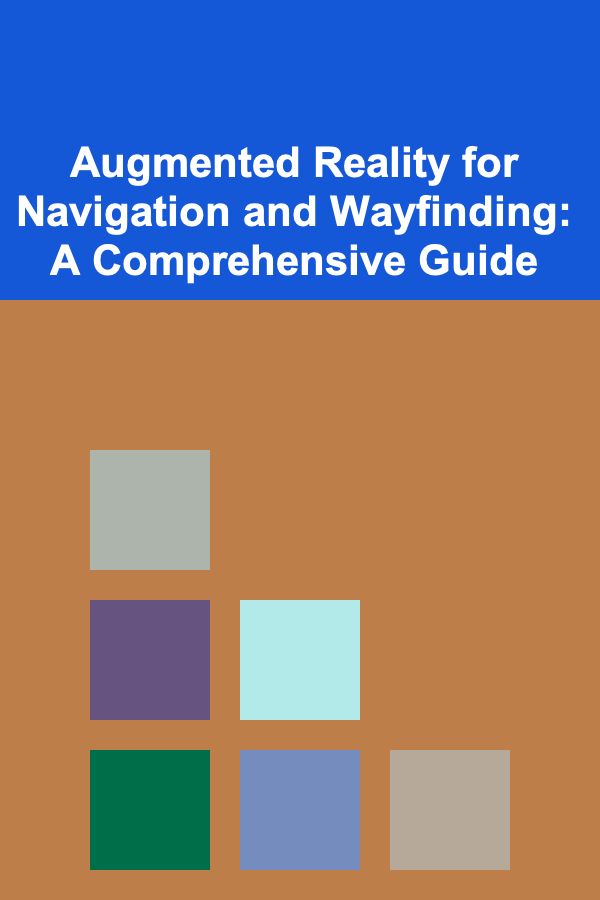
Augmented Reality for Navigation and Wayfinding: A Comprehensive Guide
ebook include PDF & Audio bundle (Micro Guide)
$12.99$8.99
Limited Time Offer! Order within the next:

Augmented Reality (AR) is rapidly transforming how we interact with the world around us, and navigation and wayfinding are no exception. By overlaying digital information onto our real-world view, AR offers a more intuitive and engaging way to find our way in unfamiliar environments. This article explores the potential of AR in navigation, delving into its underlying principles, current applications, development considerations, challenges, and future trends.
Understanding Augmented Reality and its Relevance to Navigation
Augmented Reality is a technology that enhances our perception of reality by layering computer-generated images, audio, or other sensory information onto the physical world. Unlike Virtual Reality (VR), which creates entirely simulated environments, AR augments or supplements the real world, providing users with contextual information and interactive experiences.
The core principle behind AR navigation lies in the ability to accurately track the user's position and orientation in real-time. This is typically achieved through a combination of sensors, including:
- GPS (Global Positioning System): Provides coarse location data, especially useful outdoors.
- IMU (Inertial Measurement Unit): Comprising accelerometers and gyroscopes, the IMU measures acceleration and angular velocity, enabling the device to track movement and orientation.
- Computer Vision: Algorithms that analyze camera images to identify features, recognize objects, and estimate the device's pose in the environment. This can involve techniques like SLAM (Simultaneous Localization and Mapping).
- Barometer: Measures atmospheric pressure, providing altitude information.
- Wi-Fi and Bluetooth Beacons: Used for indoor localization, where GPS signals are often unreliable. Trilateration techniques can be used to estimate position based on signal strength from multiple beacons.
These sensor inputs are processed by sophisticated algorithms to create a stable and accurate understanding of the user's location and orientation. This information is then used to overlay virtual elements, such as arrows, paths, and points of interest, onto the user's view, guiding them towards their destination.
The relevance of AR to navigation is significant because it addresses several limitations of traditional methods:
- Improved Situational Awareness: AR provides a direct and intuitive visual cue, overlaying navigation instructions directly onto the real world, making it easier to understand directions and anticipate upcoming turns.
- Enhanced User Experience: Unlike traditional maps or voice-guided navigation, AR offers a more engaging and immersive experience, reducing the cognitive load associated with interpreting abstract representations of the environment.
- Accessibility for All: AR navigation can be particularly beneficial for individuals with visual impairments or those who struggle with spatial awareness, providing them with a more accessible and intuitive way to navigate.
- Contextual Information: AR can seamlessly integrate relevant information about the surrounding environment, such as nearby landmarks, points of interest, and real-time traffic conditions, enriching the navigation experience.
Current Applications of AR in Navigation and Wayfinding
AR navigation is no longer just a theoretical concept; it's already being implemented in various real-world scenarios. Some prominent examples include:
- Pedestrian Navigation Apps: Several mobile apps utilize AR to provide turn-by-turn directions for pedestrians. These apps typically use the phone's camera to overlay virtual arrows and paths onto the user's view, guiding them through city streets and parks. Examples include Google Maps Live View and various AR navigation apps available on app stores.
- In-Car Navigation Systems: AR is being integrated into in-car navigation systems to provide drivers with a more intuitive and safer driving experience. AR-enhanced navigation displays overlay information onto the windshield, highlighting upcoming turns, lane guidance, and potential hazards.
- Indoor Navigation in Large Venues: AR is proving particularly useful for navigating complex indoor environments, such as airports, shopping malls, hospitals, and museums. These solutions often leverage indoor positioning systems (IPS) combined with AR to guide users to specific locations within the building. Imagine an airport app that overlays directional arrows on your phone's camera feed to guide you to your gate.
- Tourism and Cultural Heritage: AR can enhance the tourist experience by overlaying historical information, virtual reconstructions, and interactive exhibits onto real-world landmarks and cultural sites. Visitors can use their smartphones or tablets to access AR content that brings history to life, providing a more engaging and informative experience.
- Assisted Living and Elderly Care: AR applications can aid elderly individuals or those with cognitive impairments in navigating their homes or assisted living facilities. Simple visual cues and pathfinding assistance can improve independence and reduce disorientation.
- Emergency Response and First Responders: In emergency situations, AR can provide first responders with critical information about the environment, such as building layouts, hazard locations, and escape routes. This can improve situational awareness and enable faster and more effective response efforts.
Each of these applications leverages the strengths of AR to address specific navigation challenges, highlighting its versatility and potential across diverse domains.
Developing an AR Navigation Application: Key Considerations
Developing a robust and user-friendly AR navigation application requires careful consideration of several key factors. These include:
1. Accurate and Reliable Tracking:
The foundation of any successful AR navigation application is accurate and reliable tracking. The system must be able to determine the user's position and orientation with sufficient precision to overlay virtual elements accurately onto the real world. This requires:
- Sensor Fusion: Combining data from multiple sensors (GPS, IMU, camera, etc.) to create a more robust and accurate estimate of the user's pose. Sensor fusion algorithms, such as Kalman filters, are commonly used for this purpose.
- Environmental Mapping: Creating a detailed map of the environment, which can be used for localization and object recognition. SLAM (Simultaneous Localization and Mapping) techniques are often employed to build these maps.
- Robust Feature Tracking: Identifying and tracking visual features in the camera image to estimate the device's movement. This requires algorithms that are robust to changes in lighting, viewpoint, and occlusion.
- Calibration: Ensuring that the sensors are properly calibrated to minimize errors. This includes calibrating the camera, IMU, and other sensors.
2. User Interface (UI) and User Experience (UX) Design:
The UI and UX of an AR navigation application are crucial for ensuring a seamless and intuitive user experience. Key considerations include:
- Clarity and Simplicity: The virtual elements should be clear, concise, and easy to understand, avoiding clutter and visual noise. Focus on providing the most essential information needed for navigation.
- Contextual Relevance: The virtual elements should be contextually relevant to the user's current location and task. For example, displaying different information depending on whether the user is walking, driving, or inside a building.
- Intuitive Interactions: The application should provide intuitive ways for users to interact with the virtual elements, such as tapping on points of interest or adjusting the viewing angle.
- Minimizing Distraction: The AR overlay should not be too distracting or obstruct the user's view of the real world. Consider using subtle visual cues and avoiding excessive animations. Safety is paramount.
- Accessibility: Design with accessibility in mind. Consider options for users with visual impairments, color blindness, or other disabilities. This might include customizable color palettes, alternative visual cues, or voice-guided navigation.
- Testing and Iteration: Thoroughly test the UI and UX with real users to identify areas for improvement and refine the design based on feedback.
3. Indoor vs. Outdoor Navigation:
The development considerations for indoor and outdoor AR navigation differ significantly due to the varying availability of GPS signals and the nature of the environments.
- Outdoor Navigation: Relies primarily on GPS for localization, supplemented by IMU and camera data for more accurate tracking. Mapping data, such as OpenStreetMap, can be used to provide contextual information about the surrounding environment. Challenges include GPS signal interference in urban canyons and the need for robust tracking in varying weather conditions.
- Indoor Navigation: GPS signals are typically unavailable indoors, requiring alternative localization techniques such as Wi-Fi fingerprinting, Bluetooth beacons, or visual SLAM. Mapping indoor environments can be challenging and requires specialized tools and techniques. Challenges include maintaining accuracy in dynamic environments and dealing with changes in lighting and object arrangements.
4. Platform and Hardware Considerations:
The choice of platform and hardware can significantly impact the performance and capabilities of an AR navigation application. Consider the following:
- Mobile Devices: Smartphones and tablets are the most common platforms for AR navigation apps. They offer portability, affordability, and a wide range of sensors. However, their processing power and battery life can be limitations.
- AR Headsets: Dedicated AR headsets, such as Microsoft HoloLens and Magic Leap, offer a more immersive and hands-free AR experience. However, they are typically more expensive and less widely adopted than mobile devices.
- Processing Power: AR navigation applications require significant processing power to handle sensor fusion, environmental mapping, and rendering of virtual elements. Choose devices with powerful processors and sufficient memory.
- Battery Life: AR applications can be battery-intensive. Optimize the application for power efficiency to extend battery life.
- Camera Quality: The camera is a critical component for computer vision-based AR navigation. Choose devices with high-quality cameras that can capture clear and detailed images.
5. Data Management and Privacy:
AR navigation applications often collect and process sensitive user data, such as location, orientation, and camera images. It is essential to handle this data responsibly and protect user privacy. Consider the following:
- Data Minimization: Collect only the data that is necessary for the application to function properly.
- Data Encryption: Encrypt sensitive data both in transit and at rest.
- User Consent: Obtain explicit user consent before collecting and processing their data.
- Transparency: Be transparent about how user data is being used and provide users with control over their data.
- Compliance: Comply with all applicable privacy regulations, such as GDPR and CCPA.
Challenges and Limitations of AR Navigation
Despite its significant potential, AR navigation faces several challenges and limitations that need to be addressed:
- Accuracy and Reliability: Maintaining accurate and reliable tracking in all environments and conditions is a major challenge. GPS signals can be unreliable in urban canyons and indoors, and visual tracking can be affected by changes in lighting, viewpoint, and occlusion.
- Computational Demands: AR navigation applications require significant processing power, which can strain battery life and limit performance, especially on mobile devices.
- Hardware Limitations: The hardware capabilities of current mobile devices and AR headsets can limit the performance and capabilities of AR navigation applications. For example, limited field of view and display resolution can hinder the user experience.
- Usability and Ergonomics: Using AR navigation applications can be tiring and distracting, especially for extended periods. Ergonomic design and intuitive user interfaces are crucial for minimizing fatigue and maximizing usability. Holding up a phone for extended periods can be tiresome.
- Privacy Concerns: AR navigation applications often collect and process sensitive user data, raising privacy concerns. Addressing these concerns and ensuring user privacy is essential for building trust and adoption.
- Occlusion and Obstruction: The real world can often obstruct the virtual elements, making it difficult for users to see the navigation cues. Sophisticated occlusion handling techniques are needed to address this issue.
- Environmental Variations: AR navigation systems must be robust to changes in the environment, such as changes in lighting, weather, and object arrangements. This requires sophisticated algorithms that can adapt to varying conditions.
- Social Acceptability: Widespread adoption of AR navigation requires social acceptance. Some people may be uncomfortable with the idea of wearing AR headsets or using their phones to overlay virtual elements onto the real world. Addressing these concerns and promoting the benefits of AR navigation is crucial for driving adoption.
- Cost: The cost of developing and deploying AR navigation applications can be significant, especially for complex indoor environments. Making AR navigation more affordable and accessible is essential for widespread adoption.
Future Trends in AR Navigation
The future of AR navigation is bright, with several exciting trends on the horizon:
- Improved Accuracy and Reliability: Advancements in sensor fusion, environmental mapping, and computer vision will lead to more accurate and reliable tracking, enabling more seamless and intuitive AR navigation experiences. The integration of AI and machine learning will play a key role in improving tracking accuracy and robustness.
- More Immersive and Interactive Experiences: AR headsets with wider fields of view, higher display resolutions, and advanced interaction capabilities will create more immersive and engaging AR navigation experiences. Haptic feedback and spatial audio will further enhance the sense of presence and realism.
- Integration with Smart Cities and IoT: AR navigation will be seamlessly integrated with smart city infrastructure and the Internet of Things (IoT), providing users with real-time information about their surroundings, such as traffic conditions, parking availability, and public transportation schedules. This will enable more efficient and personalized navigation experiences.
- Personalized Navigation Experiences: AR navigation applications will leverage user data and preferences to provide personalized navigation experiences. This could include adapting the route based on the user's preferred mode of transportation, displaying points of interest that are relevant to the user's interests, and providing customized navigation cues.
- AR Cloud: The AR Cloud, a persistent and shared 3D map of the world, will play a crucial role in enabling seamless and collaborative AR experiences, including navigation. The AR Cloud will provide a common reference frame for AR applications, allowing users to interact with virtual objects and share AR experiences in the same physical location.
- Accessibility Enhancements: Future AR navigation will see increased focus on accessibility features, making navigation easier and more inclusive for individuals with disabilities. This includes improved voice control, customizable visual cues, and integrations with assistive technologies.
- AR-Enabled Public Transportation: We might see AR integrated into public transportation systems, providing passengers with real-time information about routes, schedules, and delays, as well as guiding them through stations and connecting them with other modes of transportation.
- Context-Aware Navigation: AR navigation systems will become more context-aware, adapting to the user's current situation and providing relevant information and assistance. For example, an AR navigation system could automatically detect that the user is driving and switch to a driving mode, providing lane guidance and highlighting potential hazards.
- AI-Powered Navigation Agents: The development of AI-powered navigation agents that can understand natural language and provide personalized guidance is another exciting trend. These agents could act as virtual tour guides, providing users with information about the surrounding environment and answering their questions.
Conclusion
Augmented Reality has the potential to revolutionize navigation and wayfinding, offering a more intuitive, engaging, and accessible way to find our way in the world. While challenges remain, the rapid advancements in AR technology and the growing adoption of AR applications suggest that AR navigation will become increasingly prevalent in the years to come. By carefully considering the key development considerations and addressing the challenges and limitations, we can unlock the full potential of AR to create truly transformative navigation experiences.

How to Adjust Your Home Budget for Seasonal Expenses
Read More
How to Develop a Marketing Plan for Your New Business
Read More
Why You Should Schedule Regular Decluttering Sessions
Read More
How To Understand the Impact of Product Quality on POD Sales
Read More
How to Understand Game Modding and Custom Content
Read More
How To Develop Your Artistic Talents
Read MoreOther Products

How to Adjust Your Home Budget for Seasonal Expenses
Read More
How to Develop a Marketing Plan for Your New Business
Read More
Why You Should Schedule Regular Decluttering Sessions
Read More
How To Understand the Impact of Product Quality on POD Sales
Read More
How to Understand Game Modding and Custom Content
Read More